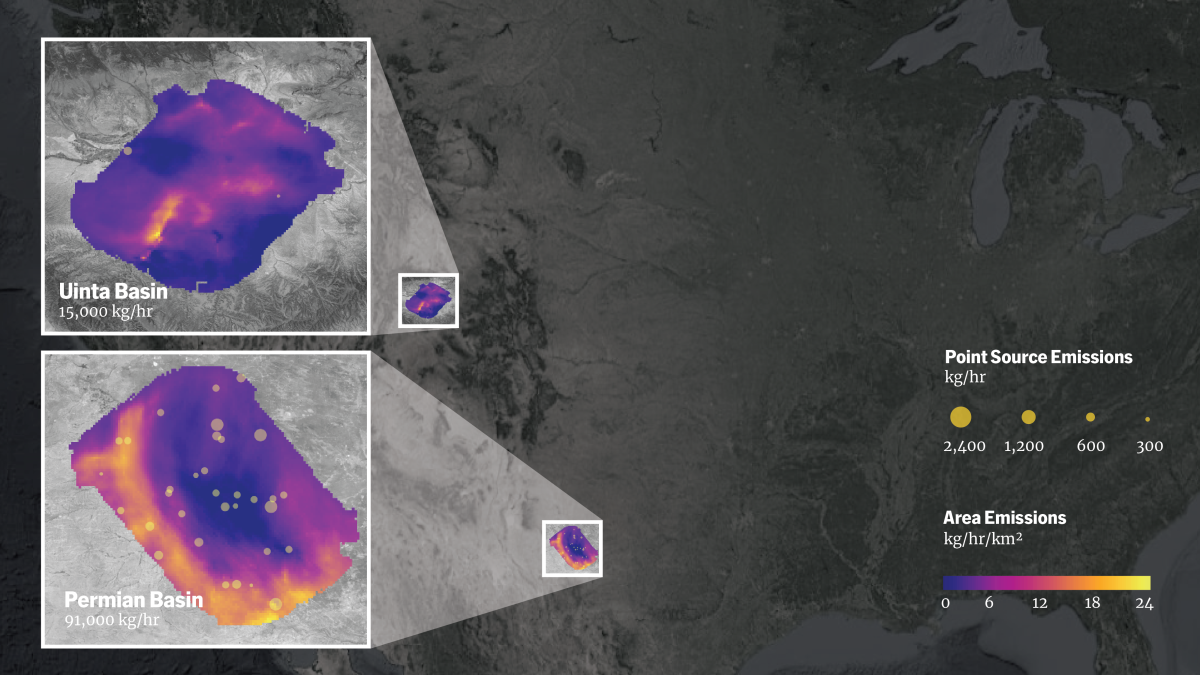New aerial monitoring of U.S. oil and gas production found that emissions of methane are more than four times higher than government estimates and eight times higher than the targets the industry has agreed to meet. The new data and another study on global methane levels released earlier this week both show that rising emissions of the powerful greenhouse gas threaten global efforts to rein in climate change.
“What we observe in our data is that the loss rate that we get is eight times higher than the industry pledges to reduce methane emissions,” Environmental Defense Fund researcher Ritesh Gautam told Newsweek. Gautam is lead senior scientist on the MethaneSAT mission at EDF, an environmental group that has developed reliable methane monitoring from airplanes and, beginning next year, from a satellite.
Gautam said the latest methane measures came from more than 30 flights over large portions of the country’s 12 major oil and gas production areas, or basins, covering about 70 percent of onshore drilling sites.
“This is probably the most comprehensive data set that’s been acquired over the onshore U.S. oil and gas production,” he said.
Methane, the main component of natural gas, does not persist in the atmosphere as long as the main greenhouse gas, carbon dioxide. But while it is in the atmosphere, methane is many times more potent as a heat-trapping gas, making it an important contributor to near-term warming.
The oil and gas industry is a major source of methane, which can escape from drilling pads, pipelines and distribution stations and is sometimes flared, or burned off, as a waste product from oil production.
Gautam said the emissions varied in different regions. The areas with the highest total methane emissions were the Appalachian Basin in Ohio, Pennsylvania and West Virginia, and the Permian Basin in Texas and New Mexico.
However, some other regions had higher rates of methane loss. EDF’s monitoring found the Uinta Basin in Utah was losing as much as 7 percent of its methane.
In a high-profile agreement announced in December during the United Nations COP28 climate talks in Dubai, 50 companies representing more than 40 percent of global oil and gas production agreed to limit methane loss to just .2 percent. The EDF data shows that the industry in the U.S.—the world’s largest producer of oil and gas—is nowhere close to meeting those targets.
“These levels of emissions are very high,” Gautam said. “To really set a good example, I think, the U.S. has to lead the effort of reducing these emissions.”
EDF said the wide gap between actual measurements and industry-reported emissions shows why transparent reporting is important. The MethaneSAT satellite launched in March carries high-precision monitoring equipment that will be able to quickly scan large areas for methane. Gautam said he expects data from the satellite to be available early next year.

In an interview with Newsweek in January, White House Climate Advisor Ali Zaidi said the Biden administration and the Environmental Protection Agency have proposed rules to better monitor and control methane emissions.
“I think we really elevated the prioritization and urgency to tackle methane, which is a super-polluting greenhouse gas, from day one of this administration,” Zaidi said.
Despite the focus on methane and international agreements to reduce emissions, recent research shows methane levels continue to climb.
A study published Monday in the online journal Frontiers in Science found that increases in atmospheric methane are “outpacing projected growth rates” and are expected to continue to increase over the remainder of the decade if no greater action is taken.
The study identified a troubling connection between human-caused emissions and methane from natural sources. As industrial greenhouse gas emissions cause more warming, the higher temperatures trigger changes in wetlands causing them to release methane from the increased decay of organic material.
“Rapid reductions in methane emissions this decade are essential to slowing warming in the near future,” the scientists wrote.
Uncommon Knowledge
Newsweek is committed to challenging conventional wisdom and finding connections in the search for common ground.
Newsweek is committed to challenging conventional wisdom and finding connections in the search for common ground.







